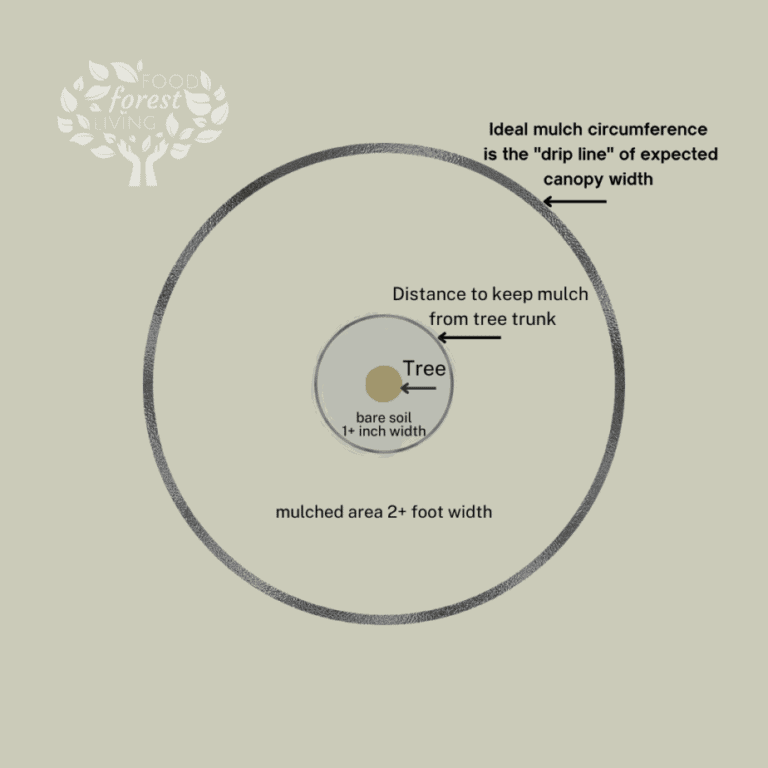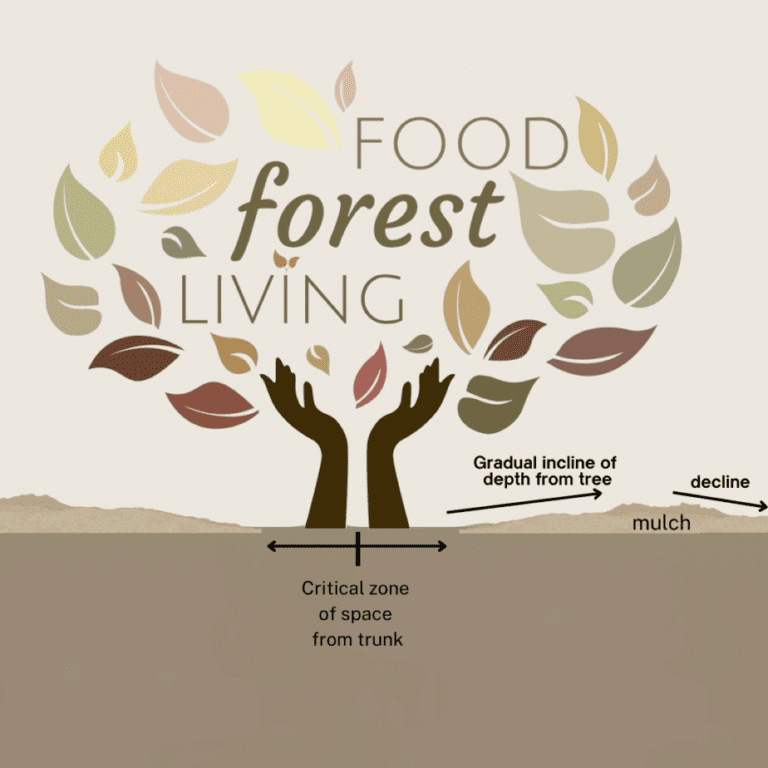This post may contain affiliate links. If you use these links to buy something we may earn a commission. Thanks.
If done correctly; mulch won’t kill your precious trees. A tree has about 3 seasons of time to be saved from incorrect mulching. The way you apply mulch is the difference between the death and life of any tree you dress.
The proper way to mulch a tree accounts for distancing, depth, and spread techniques. Distance from the trunk is the most imperative measure, then depth. The circumference width is not critical to the life of your tree but can contribute to greater growth.
This article responds to the top 3 questions for correct tree mulching and is followed by the best mulch materials to use and when to use them.
By the end, you’ll know how to mulch a tree so it can thrive.
1. Should mulch touch the tree?
It seems like the right thing to do—to mountain mulch around the tree trunk because it looks good and must feel cozy! The fact is, it is cozy that way. Too cozy. Strong trees—strong anything—won’t grow without discomfort. But really, why should mulch not touch the trunk of a tree?
Mulch should never touch a tree trunk for two reasons. Tree trunks need airflow, and roots need oxygen. A mulched tree trunk will remain moist and rot within 2-3 seasons. At the same time, vital tree roots emerge from oxygen-deprived soil and wrap around the mounded trunk.
The canopy becomes constricted from the root system as the tree base rots. The main tree inevitably dies and roots expend energy stores to arise and continue living through sprouted suckers.
Suckers are new tree shoots grown from a surviving portion of wood or root system. Before the main tree dies, suckers often grow when a tree is struggling.
If the top portion of a nursery-cultivated fruit tree dies, you’ll lose the chosen fruit variety (eg. Bartlett pear) and end up with a “wild card.” Wild card fruit comes from the rootstock. The rootstock was bred to grow great roots and not great fruits!
Prevent these losses by keeping mulch clear of the trunk at all times.
2. How far should mulch be from the tree trunk?
Every source claims their own made-up number of “inches away” to keep mulch clear of a tree trunk. A proper distance can be more or less by choice as long as it isn’t touching nor piled sky-high.
Keep mulch 1-8 inches away from the trunk of any tree. Choose the exact distance by personal preference, so long as it does not touch the tree. From that point, spread the mulch circumference two or more feet. The wider weed-free width you dress, the faster and farther a tree will grow.
Mutual partners work best with their own space. Bare soil between the tree and where the mulch begins is critical to a healthy trunk and roots. Mulch is favorable for suppressing weeds and building soil when physically apart from the tree.

This article was originally published on foodforestliving.com. If it is now published on any other site, it was done without permission from the copyright owner.
Wide-spread mulch offers a low-competition space for trees to establish and flourish. The width to which you can mulch has no limit.
3. Can you have too much mulch?
We’ve made the mistake of over-mulching our trees many times for good intended reasons. We’ve learned that it’s better to mulch wider than thicker when using up extra woodchips and such.
Mulch thicker than 4 inches can cause a tree’s roots to grow in non-ideal “territory.” The mulch layer becomes an attractive breath of air when the buried topsoil suffocates the roots. Two considerable consequences occur when roots grow into the mulch.
- Parched-prone nonwoody roots. The particle size of mulch is bigger than soil, which means there is more air space. In droughts, mulch will often dry out while the soil beneath stays moist. If too many nonwoody roots are in the mulch and dry to a crisp, they die, and unnecessary energy and water loss weaken the tree.
- Malnourished nonwoody roots. Mulch will eventually become nutrient-rich soil. But until then, nutrients are tied up and unavailable to plants in their current composition. Half the job of nonwoody roots is to absorb nutrients. If they’re up in the mulch, they aren’t finding bio-available food!
A bonus consequence for severely over-mulched trees is decreased stability. Woody lateral roots may grow closer to the soil surface than they otherwise would. But lateral roots also grow far beyond a mulch ring.
The ideal mulch spread technique that we use:
The mulch closest to the tree should be the thinnest. Gradually increase the depth toward the top of the “pile” (middle of the mulch ring) and taper it off at the outer edge. See image:

Also, mind your material. Coarse material settles with bigger gaps for gas exchange than fine material.
- For coarse mulch; keep the peak at a 4-inch depth or less.
- For fine mulch; keep the peak at a 2-inch depth or less.
Our mistake: an overly generous Mushroom bed
Mushroom beds can partner with fruit trees if done right.
What we did:
The first time we planted fruit trees, we made their mulch rings into overflowing King Stropharia mushroom beds. Mushroom beds can range from 4-8 inches in depth.
Since there were established grasses and weeds growing, we went for a thicker bed to ensure they wouldn’t make it through.
Although we abided by the space-from-the-trunk rules, we didn’t know there was still a height limit that would affect tree roots.
A year later I went to top up the mulch to feed the mushrooms, and I noticed the nonwoody roots right near the surface—No wonder the tree suckered!
What we should have done:
To make a friendly mushroom bed below your tree, simply keep the depth under 4 inches.
To deal with weeds, “sheets” can be more appropriate than depth for light deprivation.
Related post: Do you put anything under mulch? Yes (and No…)
What is the best thing to put around the base of a tree?
The base of the tree, also known as the ground beside the trunk, benefits either from coverage or companions. The best choice is nourishing and low competition.
Wood mulch and leaf litter are the best materials to put around the base of trees. Natural mulch smothers weeds and breaks down into nutrient-rich soil over time. Either dig up and remove any established weeds, or sheet mulch before applying a shredded mulch layer.
Summary
- Do mulch your trees to suppress competition
- Don’t pile the mulch like a mountain up against the trunk
- Do keep a space between the trunk and mulch so they don’t touch
- Don’t mulch anywhere higher than 4 inches
- Do spread mulch wider than 2 feet, even all the way to the expected drip line of the canopy
- Don’t use inorganic material as permanent mulch for permanent plants
Recent Posts
There’s no shortage of full-sun ground covers for zone 4 climates! Each plant in this list can withstand the frigid temperatures and also enjoy the hot sun in summer. Full sun means that a plant...
There's no shortage of full sun ground covers, not even in zone 3! Zone 3 climates offer hot but short-lived summers and very cold winters. So each plant in this list can withstand the frigid...

